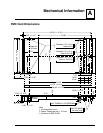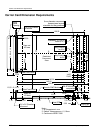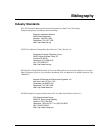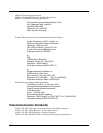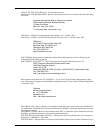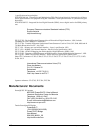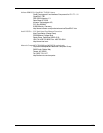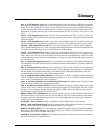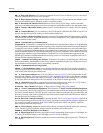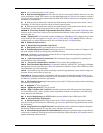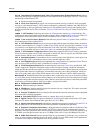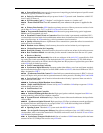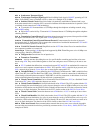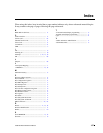
4538 Hardware Reference Manual 121
Glossary
AAL ATM Adaptation Layer Service-dependent sublayer of the data link layer. The AAL accepts data
from different applications and presents it to the ATM layer in the form of 48-byte ATM payload segments.
AALs consist of two sublayers: CS and SAR. AALs differ on the basis of the source-destination timing used,
whether they use CBR or VBR, and whether they are used for connection-oriented or connectionless mode
data transfer. At present, the four types of AAL recommended by the ITU-T are AAL1, AAL2, AAL3/4, and
AAL5.
AAL1 ATM Adaptation Layer 1One of four AALs recommended by the ITU-T. AAL1 is used for con-
nection-oriented, delay-sensitive services requiring constant bit rates, such as uncompressed video and other
isochronous traffic.
AAL2 ATM Adaptation Layer 2 One of four AALs recommended by the ITU-T. AAL2 is used for con-
nection-oriented services that support a variable bit rate, such as some isochronous video and voice traffic.
AAL3/4 ATM Adaptation Layer 3/4 One of four AALs (merged from two initially distinct adaptation
layers) recommended by the ITU-T. AAL3/4 supports both connectionless and connection-oriented links, but
is primarily used for the transmission of SMDS packets over ATM networks.
AAL5 ATM Adaptation Layer 5 One of four AALs recommended by the ITU-T. AAL5 supports con-
nection-oriented VBR services and is used predominantly for the transfer of classical IP over ATM and LANE
traffic. AAL5 uses SEAL and is the least complex of the current AAL recommendations. It offers low band-
width overhead and simpler processing requirements in exchange for reduced bandwidth capacity and error-
recovery capability.
AIN Advanced Intelligent Network In SS7, an expanded set of network services made available to the
user, and under user control, that requires improvement in network switch architecture, signaling capabilities,
and peripherals.
AMI Alternate Mark Inversion Line-code type used on T1 and E1 circuits. In AMI, zeros are represented
by 01 during each bit cell, and ones are represented by 11 or 00, alternately, during each bit cell. AMI requires
that the sending device maintain ones density. Ones density is not maintained independently of the data
stream. Sometimes called binary coded alternate mark inversion.
API Application Programming Interface (1) The interface to a library of language-specific subroutines
(such as a graphics library) that implement higher-level functions. (2) A set of calling conventions defining
how a service is invoked through a software package.
ASCII American Standard Code for Information Interchange The standard binary encoding of alpha-
betical characters, numbers, and other keyboard symbols.
ATM Asynchronous Transfer Mode International standard for cell relay in which multiple service types
(such as voice, video, or data) are conveyed in fixed-length (53-byte) cells. Fixed-length cells allow cell pro-
cessing to occur in hardware, thereby reducing transit delays. ATM is designed to take advantage of high-
speed transmission media such as E3, SONET, and T3.
B8ZS Binary 8-Zero Substitution Line-code type, used on T1 and E1 circuits, in which a special code is
substituted whenever 8 consecutive zeros are sent over the link. This code is then interpreted at the remote
end of the connection. This technique guarantees ones density independent of the data stream. Sometimes
called bipolar 8-zero substitution.
B Channel Bearer Channel In ISDN, a full-duplex, 64-kbps channel used to send user data.
BIOS Basic Input/Output System The built-in program that controls the basic functions of communica-
tions between the processor and the Input/Output (I/O) devices of a computer.
BISDN Broadband ISDN ITU-T communication standards designed to handle high-bandwidth applica-
tions such as video. BISDN currently uses ATM technology over SONET-based transmission circuits to pro-
vide data rates from 155 to 622 Mbps and beyond.
bootROM boot Read-Only Memory Chip mounted on the printed circuit board used to provide execut-
able boot instructions to a computer device.




